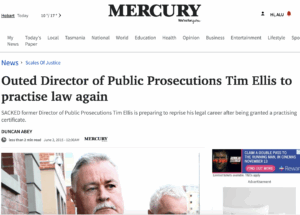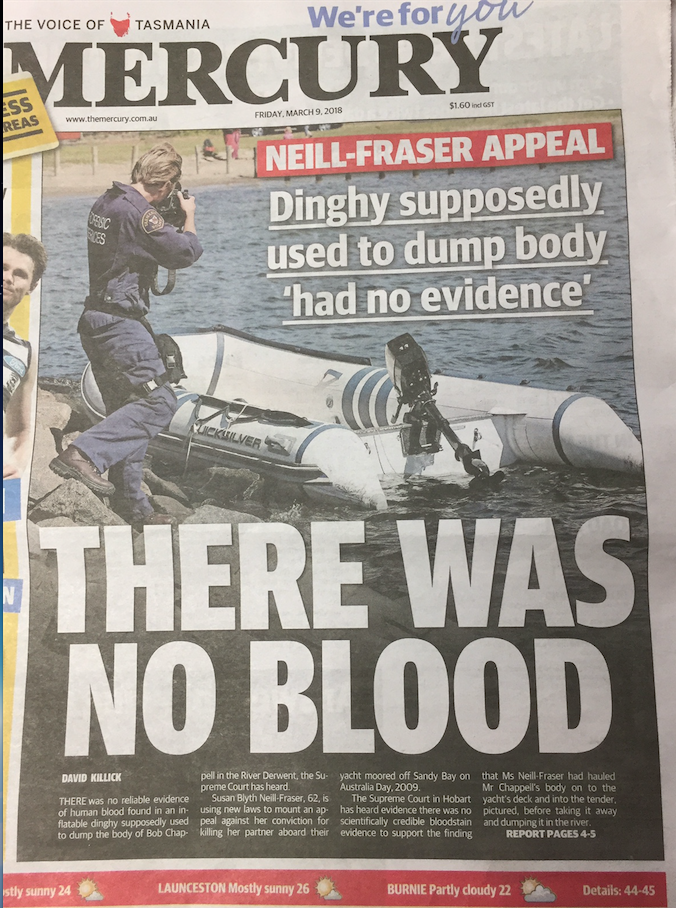The Red Herring Certificate identifies prosecutors and judges who, in our sincere opinion supported by evidence, have helped bring about wrongful convictions.
This certificate is named in recognition of the first recipient, Tim Ellis SC, the disgraced former Tasmanian DPP who prosecuted (?persecuted?) Sue Neill-Fraser in the 2010 trial for the murder of her partner Bob Chappell, relying purely on circumstantial evidence – and his speculations. He infamously and frequently referred to evidence that didn’t fit his speculations, including DNA evidence, as ‘red herrings’.

Making news in The Mercury
Following his dismissal from the DPP position in 2015 after a conviction for negligent driving causing death, Ellis reinstated his practicing certificate and returned to private practice as a barrister in Launceston – where he began his career.
This Certificate recognises the enormous contribution Ellis made to what we believe to be the wrongful conviction of Sue Neill-Fraser.
ELLIS RED HERRINGS
The words ‘red herring/s’ appear on 19 pages of the trial transcript, sometimes more than once. Trial Judge Alan Blow contributed several himself – and will be the next recipient of a Certificate himself.
Examples – from Ellis Closing:
“ … we’ve had Meaghan Vass, a sixteen year old homeless girl, bullied and chased around by Mr Gunson all because some of her DNA was found in the one spot on Four Winds, one spot, one spot only, on the top of the deck – a sixteen year old girl.
“…the whole thing is such a red herring because when you realize that the DNA could have been transferred from someone onto Four Winds, and the number of people who were there and where they came from, it’s – it was a refinement of that red herring to say, “Were you down at Constitution Dock then?” as if she had necessarily stepped onboard, or even if someone had necessarily acquired some trace of her DNA, some strong sign of her DNA on their footwear before getting on the yacht.
“Well I want now to just mention some of the red herrings and so on that have been thrown about. No doubt you’ll hear much more about them from Mr Gunson when he speaks to you, after all it’s been the way the case has been conducted I suggest, red herring, red herring, red herring, with the boats, must add up to a doubt, you’ve got so many red herrings. It’s like that interesting program that the man from the Victorian police showed us how you can look at the bottom of the Derwent, there was a school of fish, well it could have been a school of red herrings as far as this case is concerned because that’s how many have been strewn about.
“…her DNA became on the database and it was matched. But where does that leave us? Where did that red herring take us? Why was that girl pursued?
Why was she bullied and argued with so fiercely? Was it because it was wanted for you to seriously entertain a reasonable doubt that she’s responsible for this killing?”
“ Meaghan Vass, a red herring, a red herring, should not have been, I suggest, pursued in this case …”
In a rare public comment (Mercury, Sept. 16, 2021) on a case in which he was prosecutor, the former Tasmanian DPP refutes former Premier Lara Giddings’ claims published the day before. Maybe he shouldn’t have …
“THE latest contribution by Lara Giddings (Talking Point, September 15) compels me, reluctantly, to respond,” he begins. After refuting Giddings’ example of the Peter Lorraine testimony, Ellis turns to the matter of “blood in the dinghy”. (The dinghy in which, he had speculated at trial, the murdered, bloody body of Bob Chappell, had been taken from the yacht and dumped in the water by Neill-Fraser…)
“ … in the so called “Etter /Selby papers” much time and space is devoted to seeking to prove that the prosecution’s case that there was blood in the dinghy was wrong and that matters contrary to that proposition were hidden.
It was never the prosecution case that there was blood in the dinghy. I never said the jury could so find at any stage of the trial, and no submission invited them to so find.
Ms Etter knows this well. Ms Etter had complained to the Legal Profession Board (LPB)* that I falsely denied after the trial that I had told the jury that there had been found to be blood in the dinghy.
That complaint was examined by the LPB (Legal Profession Board) who concluded that there had been no presentation of a blood in the dinghy case and no assertion of it by me and Ms Etter’s complaint was summarily dismissed. (We have no confidence in the LPB.)
The trial transcript tells a different story, and shows how Ellis let his speculation run rampant :
CT639: STATE v. NEILL-FRASER P-70 MR ELLIS SC / HOBART 21.9.10 OPENING
As we go through it and could you come perhaps to photograph 21, and what does that show?……This is a photograph that was taken to show the areas that glowed with the luminol screening test for blood.
***
CT 1348 S.B. NEILL-FRASER / HOBART 12.10.10 XXD MR ELLIS SC You lowered his body into the dinghy and you took it somewhere into the deeper channels of the Derwent ….
CT 1351 S.B. NEILL-FRASER / HOBART 12.10.10 XXD MR ELLIS SC … you completed the work and disposed of Mr Chappell’s body by using winches to haul him out and the fire extinguisher and other things. You wrapped him up in some form of doona or cloth or a sail cloth or something with the carpet pieces which were bloody and which you’d removed …..
***
CT 1486 HIS HONOUR, COUNSEL, JURY ABSENT– SUBMISSIONS, PRIOR TO SUMMING UP, 13.10.10
MR ELLIS SC: The next point is, it was attributed to me that I said it was Mr Chappell’s blood in the dinghy. Now I don’t believe I did.
MR GUNSON SC: Yes, you did.
MR ELLIS SC: Okay – I don’t know why I’d say it
HIS HONOUR: – Well –
MR ELLIS SC: – because I’ve never believed it.
HIS HONOUR: In opening.
MR GUNSON SC: Yeah.
MR ELLIS SC: Oh in opening –
MR GUNSON SC: Yes, in opening.
MR ELLIS SC: Oh okay, I abandon that, if I said it in opening.
HIS HONOUR: All right. Well I’ll do nothing about that point. What’s the next point?

The Mercury, March 9, 2018
* His Honour Justice Blow (since retired as Chief Justice) indeed did nothing about this point, not even telling the jury that the prosecutor did not believe there was blood in the dinghy. Nor did Ellis himself advise the jury of this revelation. Why not? Like Mr Gunson and His Honour himself, the jury was thus left with the assumption that there was blood in the dinghy, to fit the prosecution’s speculation, as supported by the blue luminal stained dinghy. Was that misleading the jury?
- Ellis was merely speculating how the crime may have been committed, which is why he “never believed” there was blood in the dinghy, as he told the judge and defence, jury absent…
- Ellis didn’t believe there was blood in the dinghy, so why did he show the photo of the luminol stained dinghy to the jury?
- Did Ellis show the prejudicial photo to the 2010 jury in ignorance of luminol’s proper and accepted use as he claimed in a 2017 response to the Legal Profession Board (see his comment above)? And if that’s the case, why did he say to the jury in his Opening:
ELLIS Opening CT71
But the tender itself was also subjected to a screening test for blood called luminol, and what happens with luminol is you put it – you put it on objects where there might have been blood and turn off the lights and it gets lum – it goes luminous in the presence of blood, and so that reacted quite strongly, the tender and the inside of the tender for the presence of blood, and swabs taken from the tender were found to match, with a high degree of probability, Mr Chappell’s DNA. But on the other hand another screening agent for blood taken on that tender showed negative and one of the forensic scientists looked under the microscope to try and find some – what they look for is red/brown indications of blood and couldn’t find any, so some indications of blood, his DNA, but others – others, no.
Ellis has such a fascination for the idea of red herrings, defence counsel, the late David Gunson SC, made a point of it to the jury in his Closing CT1430:
Now if something apparently doesn’t suit Mr Ellis’ case and he doesn’t like it, then it’s immediately labelled a ‘red herring’ – ‘it’s a red herring or we don’t like that – the grey dinghy is a red herring, we don’t like that, what a horrible red herring that is – chuck it aside members of the jury, ignore it’. Well if you do that you’d ignore your oath. ‘Chuck aside the DNA. It doesn’t fit my case and I’m sorry it’s here but just ignore it, it’s a red herring’, and I would suggest to you that Mr Ellis’ fascination with red herrings and to describe any evidence that he doesn’t like, which doesn’t suit the prosecution case, is singularly unhelpful to you as members of the jury, when setting about determining this case.
Coming soon:
Sue Neill-Fraser trial judge (later Tasmanian Chief Justice now retired) Alan Blow to receive the Red Herring Certificate

Well put Andrew
can I sign the Red Herring Certificate for ELLIS SC please.
lol; following the speculation modus operandi of then DPP, I speculate there are numerous observers, wanting their ‘ghost signatures’ to be added.
Susan Neill Fraser is a victim of a corrupt legal system………who has a vested interest in Red Herring view points……..as in my opinion she is due for reparation of a huge amount of money in compensation for a wrongful conviction. Bring on her EXONERATION.
What an appropriate subject to re-introduce the most scandalous wrongful conviction on “ The Derwent” Andrew, the ‘red herring’!
This shoal of fishy circumstances that lured in some of Tasmania’s very dishonourable public servants who all fabricated their own stories for a lazy catch of the day is not before time.
The “red herring” award is so significant for these antagonists who did all in their power to send the jury members down the wrong path and unfortunately they succeeded.
Good that you are back on Sue’s miscarriage of justice Andrew. Been a while!